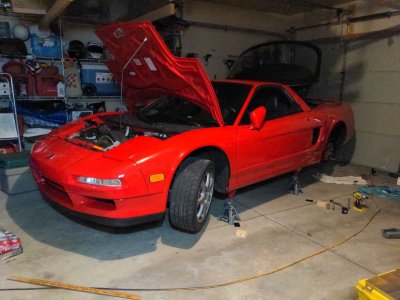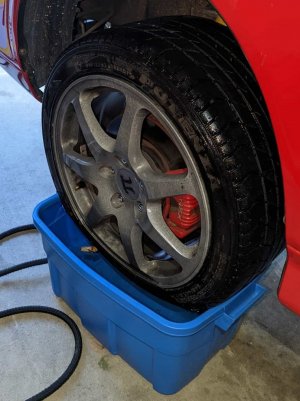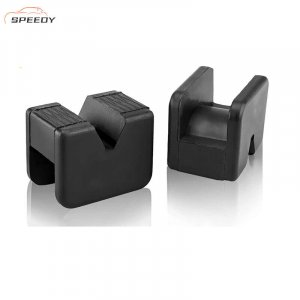I decided that I finally should get around to changing out my coolant hoses and thermostat. The new parts have been sitting in a box for three years now. The plan is to get the car up on jack stands at the jack points and I have seen photos posted of the NSX supported like this. I have supported the car on jack stands using the brake rotor hats as the support points. Fairly easy to do that; but, I am not super enthusiastic about that option because the hats are not very wide resulting in a relatively small contact area on my particular stands. Not keen about getting under the car and yanking on the hoses without a really secure support.
The thing about using the jack points is that they are significantly lower than the rotor hats meaning the car has to get a lot higher in the air to fit the stands. I figure I can use my floor jack on the center jack point and get the jack stands on their lowest position under the two jack points on one side ; but, when I go to the other side the car is going to be tipped over enough that I don't think my floor jack will get under the sill with the rubber pinch weld adapter in place. Even if it did fit, the whole idea of then jacking up the second side with the other side on stands just seems like a bad idea - I can just see one of the stands starting to slide across the garage floor as the car starts to raise. If I could jack from the front or the back I think I could do this; but, I don't think that is an option on the NSX. My son's RSX actually has a center jack point in the front which he uses to get the front of the car up on jack stands.
So I appear to be old guy challenged and can't figure out how to safely get from here to there. Right now I am thinking a trip to Home Depot, purchase a 6x6 timber and cut it into blocks to fit under all four tires. A Quick Jack thingy (or similar) would be nice; but, not an option because I already have too much junk in the garage.
The thing about using the jack points is that they are significantly lower than the rotor hats meaning the car has to get a lot higher in the air to fit the stands. I figure I can use my floor jack on the center jack point and get the jack stands on their lowest position under the two jack points on one side ; but, when I go to the other side the car is going to be tipped over enough that I don't think my floor jack will get under the sill with the rubber pinch weld adapter in place. Even if it did fit, the whole idea of then jacking up the second side with the other side on stands just seems like a bad idea - I can just see one of the stands starting to slide across the garage floor as the car starts to raise. If I could jack from the front or the back I think I could do this; but, I don't think that is an option on the NSX. My son's RSX actually has a center jack point in the front which he uses to get the front of the car up on jack stands.
So I appear to be old guy challenged and can't figure out how to safely get from here to there. Right now I am thinking a trip to Home Depot, purchase a 6x6 timber and cut it into blocks to fit under all four tires. A Quick Jack thingy (or similar) would be nice; but, not an option because I already have too much junk in the garage.











![IMG_3958[1].JPG IMG_3958[1].JPG](https://www.nsxprime.com/data/attachments/132/132276-ad5a6e0c75bcff9dc26d0603a639b026.jpg)

